
Richmond Kelly Turner was born in Portland, Oregon, on 27 May 1885. Appointed to the U.S. Naval Academy from California in 1904, he graduated in June 1908 and served in several ships over the next four years. In 1913, Lieutenant (Junior Grade) Turner briefly held command of the destroyer Stewart. After receiving instruction in ordnance engineering and service on board the gunboat Marietta, he was assigned to the battleships Pennsylvania, Michigan and Mississippi during 1916-19.
From 1919 to 1922, Lieutenant Commander Turner was an Ordnance Officer at the Naval Gun Factory in Washington, D.C.. He then was Gunnery Officer of the battleship California, Fleet Gunnery Officer on the Staff of Commander Scouting Fleet and Commanding Officer of the destroyer Mervine. Following promotion to the rank of Commander in 1925, Turner served with the Bureau of Ordnance at the Navy Department. In 1927, he received flight training at Pensacola, Florida, and a year later became Commanding Officer of the seaplane tender Jason and Commander Aircraft Squadrons, Asiatic Fleet. He had further aviation-related assignments into the 1930s and was Executive Officer of the aircraft carrier Saratoga in 1933-34. Captain Turner attended the Naval War College and served on that institution's staff in 1935-38. He next commanded the heavy cruiser Astoria and took her on a diplomatic mission to Japan in 1939.
Captain Turner was Director of the War Plans Division in Washington, D.C., in 1940-41 and achieved the rank of Rear Admiral late in the latter year. He was Assistant Chief of Staff to the Commander in Chief, U.S. Fleet from December 1941 until June 1942 and was then sent to the Pacific war zone to take command of the Amphibious Force, South Pacific Force. Over the next three years, while holding a variety of senior Pacific Fleet amphibious force commands as both a Rear Admiral and Vice Admiral, he planned and executed the conquest of enemy positions in the south, central and western Pacific, contributing greatly to ultimate victory in the World's greatest naval war. In the rank of Admiral, he would have commanded the amphibious component of the invasion of Japan, had that nation not capitulated in mid-1945.
Following the end of World War II, Admiral Turner served on the Navy Department's General Board and was U.S. Naval Representative on the United Nations Military Staff Committee. He retired from active duty in July 1947. Admiral Richmond K. Turner died in Monterey, California, on 12 February 1961.
The guided missile frigate (later cruiser) Richmond K. Turner (DLG-20, later CG-20) was named in honor of Admiral. Turner.
This page features selected views of Admiral Richmond K. Turner.
| If you want higher resolution reproductions than the "Online Library's" digital images, see: "How to Obtain Photographic Reproductions." |
Click on the small photograph to prompt a larger view of the same image.
|
Photo #: 80-G-216636 Rear Admiral Richmond Kelly Turner, USN, Commander, Fifth Amphibious Force On board ship off Kwajalein, during the Marshalls operation, 18 February 1944. Official U.S. Navy Photograph, now in the collections of the National Archives. Online Image: 79KB; 590 x 765 pixels Reproductions of this image may also be available through the National Archives photographic reproduction system. |
 |
|
Photo #: 80-G-231988 Vice Admiral Richmond Kelly Turner, USN On board USS Rocky Mount (AGC-3) off Saipan, 17 June 1944. Official U.S. Navy Photograph, now in the collections of the National Archives. Online Image: 72KB; 740 x 615 pixels Reproductions of this image may also be available through the National Archives photographic reproduction system. |
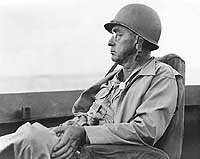 |
|
Photo #: 80-G-309855 Vice Admiral Richmond Kelly Turner, USN, Commander Amphibious Forces, U.S. Pacific Fleet At his desk at Pacific Fleet Headquarters, circa 1944. Official U.S. Navy Photograph, now in the collections of the National Archives. Online Image: 83KB; 740 x 610 pixels Reproductions of this image may also be available through the National Archives photographic reproduction system. |
 |
|
Photo #: 80-G-309643 Vice Admiral Richmond Kelly Turner, USN On board his flagship, USS Eldorado (AGC-11), at the time of the Ryukyus operation, March 1945. Official U.S. Navy Photograph, now in the collections of the National Archives. Online Image: 62KB; 600 x 765 pixels Reproductions of this image may also be available through the National Archives photographic reproduction system. |
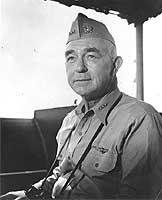 |
|
Photo #: 38-MCN-537-1 Admiral Richmond Kelly Turner, USN Photographic portrait by Maurice Constant, taken during the World War II era Photograph from the Collections of the U.S. National Archives. Online Image: 64KB; 590 x 765 pixels |
 |
|
Photo #: 80-G-607995 Admiral Richmond Kelly Turner, USN Portrait photograph, taken circa 1945-1947. Official U.S. Navy Photograph, now in the collections of the National Archives. Online Image: 66KB; 585 x 765 pixels Reproductions of this image may also be available through the National Archives photographic reproduction system. |
 |
|
Photo #: NH 46308 USS Marietta (Gunboat # 15) Ship's officers, 8 May 1914. They are (seated, left to right): Lieutenant George M. Baum; Commander William Pitt Scott; and Passed Assistant Paymaster Raymond E. Corcoran. (standing, left to right): Lieutenant (Junior Grade) Joseph S. Evans; Assistant Surgeon Thomas A. Fortescue; Lieutenant (Junior Grade) Richmond K. Turner; Lieutenant (Junior Grade) Henry T. Markland; and Ensign Hugh V. McCabe. Donation of Captain J.S. Evans, 1963. U.S. Naval Historical Center Photograph. Online Image: 94KB; 740 x 615 pixels |
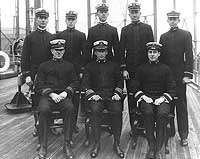 |
|
Photo #: NH 84424 Commander Richmond K. Turner, USN (center, holding cap) With other aviators at Naval Air Station, Pensacola, Florida, in 1927, while he was receiving flight training. Officer on the far right end of the rear group of five is Lieutenant Daniel V. Gallery. The aircraft is a Martin SC floatplane, with bomb racks mounted below its wings. Courtesy of the Naval Historical Foundation, Washington, D.C. Collection of Fleet Admiral Ernest J. King. U.S. Naval Historical Center Photograph. Online Image: 117KB; 740 x 520 pixels |
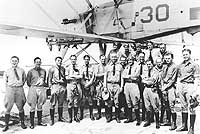 |
|
Photo #: NH 76147 Captain Richmond Kelly Turner, USN (left), Commanding Officer of USS Astoria (CA-34), with Hachiro Arita, Foreign Minister of Japan. At the Foreign Minister's official residence, in Tokyo, during Astoria's visit to Japan in April 1939. She had brought home the ashes of the Late Japanese Ambassador to the United States, Hiroshi Saito, who died in Washington, D.C., on 26 February 1939. Halftone reproduction, published in the "Japan Times Weekly", Tokyo, 20 April 1939, page 569. Donation of Lieutenant Gustave Freret, USN (Retired), 1972. U.S. Naval Historical Center Photograph. Online Image: 128KB; 545 x 765 pixels |
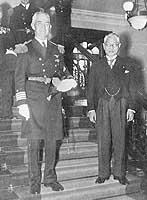 |
|
Photo #: 80-CF-112-4-63 Rear Admiral Richmond Kelly Turner, USN (left), and Major General Alexander A. Vandegrift, USMC Working on the flag bridge of USS McCawley (AP-10), at the time of the Guadalcanal-Tulagi operation, circa July-August 1942. Photograph from Department of the Navy collections in the U.S. National Archives. Online Image: 88KB; 740 x 620 pixels Reproductions of this image may also be available through the National Archives photographic reproduction system. |
 |
|
Photo #: 80-G-203818 Rear Admiral Richmond Kelly Turner, USN Congratulates Private First Class Carl Emanuel Magnuson, USMC, after presenting him with the Purple Heart medal for wounds received in the invasion of the Gilbert Islands. The ceremony took place on board a hospital ship at Pearl Harbor, on 17 December 1943. Official U.S. Navy Photograph, now in the collections of the National Archives. Online Image: 98KB; 740 x 610 pixels Reproductions of this image may also be available through the National Archives photographic reproduction system. |
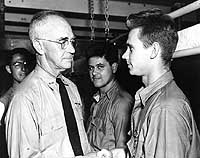 |
| If you want higher resolution reproductions than the "Online Library's" digital images, see: "How to Obtain Photographic Reproductions." |
Page made 2 November 2001